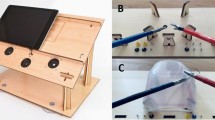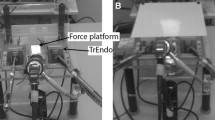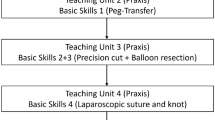Abstract
Background
Although excellent training programs exist for acquiring the challenging skill required in laparoscopic suturing, without subsequent reinforcement, performance is prone to decay. Therefore, maintenance training is proposed to ensure better skill retention. This study aimed to elucidate the ideal timing and frequency of maintenance training as well as the best model to be used for this training.
Methods
After completing a proficiency-based laparoscopic suturing training, 39 medical students attended different maintenance programs represented by four groups: a control group without additional training (group 1), a massed training group with one supervised training session (150 min) after 2.5 months (group 2), and two distributed training groups with five monthly unsupervised training sessions of 30 min on a box trainer (group 3) or the LapMentor® (group 4). Retention testing, after 5 months, included suturing on a box trainer and on a cadaver porcine Nissen model. Performance scores (time and errors) were expressed in seconds. Afterward, time needed to regain proficiency was measured.
Results
On the box trainer, the median performance scores were 233 s (interquartile range [IQR] 27 s) for group 1, 180 s (IQR 55 s) for group 2, 169 s (IQR 26 s) for group 3, and 226 s (IQR 66 s) for group 4 (p = 0.03). No difference was seen between groups 2 and 3, both of which significantly outperformed groups 1 and 4. On the porcine Nissen model, no differences were detected between the groups (p = 0.53). Group 3 reached proficiency more quickly than the other groups.
Conclusions
Maintenance training is a valuable and necessary addendum to proficiency-based training programs for laparoscopic suturing. A maintenance-training interval of 1 month with unsupervised training sessions on simple box trainers seems ideal. The LapMentor® did not show any benefit. Performance differences between groups did not translate to a clinically relevant model, indicating that transfer of training is not perfect.



Similar content being viewed by others
References
Berg DA, Milner RE, Fisher CA, Goldberg AJ, Dempsey DT, Grewal H (2007) A cost-effective approach to establishing a surgical skills laboratory. Surgery 142:712–721
Korndorffer JR Jr, Dunne JB, Sierra R, Stefanidis D, Touchard CL, Scott DJ (2005) Simulator training for laparoscopic suturing using performance goals translates to the operating room. J Am Coll Surg 201:23–29
Castellvi AO, Hollett LA, Minhajuddin A, Hogg DC, Tesfay ST, Scott DJ (2009) Maintaining proficiency after fundamentals of laparoscopic surgery training: a 1-year analysis of skill retention for surgery residents. Surgery 146:387–393
Stefanidis D, Korndorffer JR Jr, Markley S, Sierra R, Scott DJ (2006) Proficiency maintenance: impact of ongoing simulator training on laparoscopic skill retention. J Am Coll Surg 202:599–603
Mashaud LB, Castellvi AO, Hollett LA, Hogg DC, Tesfay ST, Scott DJ (2010) Two-year skill retention and certification exam performance after fundamentals of laparoscopic skills training and proficiency maintenance. Surgery 148:194–201
Van Bruwaene S, De Win G, Miserez M (2009) How much do we need experts during laparoscopic suturing training? Surg Endosc 23:2755–2761
Edelman DA, Mattos MA, Bouwman DL (2010) Association for academic surgery: FLS skill retention (learning) in first-year surgery residents. J Surg Res 163:24–28
Miserez M, Arregui M, Bisgaard T, Huyghe M, Van Bruwaene S, Peeters E, Penninckx F (2009) A standardized resident training program in endoscopic surgery in general and in laparoscopic totally extraperitoneal (TEP) inguinal hernia repair in particular. Surg Laparosc Endosc Percutan Tech 19:e125–e129
Moulton CE, Dubrowski A, Macrae H, Graham B, Grober E, Reznick R (2006) Teaching surgical skills: what kind of practice makes perfect? A randomized, controlled trial. Ann Surg 244:400–409
McDougal EM, Kolla SB, Santos RT, Gan JM, Box GN, Louie MK, Gamboa AJ, Kaplan AG, Moskowitz RM, Andrade LA, Skarecky DW, Osann KE, Clayman RV (2009) Preliminary study of virtual reality and model simulation for learning laparoscopic suturing skills. J Urol 182:1018–1025
Munz Y, Almoudaris AM, Moorthy K, Dosis A, Liddle AD, Darzi AW (2007) Curriculum-based solo virtual reality training for laparoscopic intracorporeal knot tying: objective assessment of the transfer of skill from virtual reality to reality. Am J Surg 193:774–783
Verdaasdonck EG, Dankelman J, Lange JF, Stassen LP (2008) Transfer validity of laparoscopic knot-tying training on a VR simulator to a realistic environment: a randomized controlled trial. Surg Endosc 22:1636–1642
Stefanidis D, Korndorffer JR Jr, Black FW, Dunne JB, Sierra R, Touchard CL, Rice DA, Markert RJ, Kastl PR, Scott DJ (2006) Psychomotor testing predicts rate of skills acquisition for proficiency-based laparoscopic skills training. Surgery 140:252–262
Stefanidis D, Acker C, Heniford BT (2008) Proficiency-based laparoscopic simulator training leads to improved operating room skill that is resistant to decay. Surg Innov 15:69–73
Van Sickle KR, Baghai M, Huang I, Goldenberg A, Smith CD, Ritter EM (2008) Construct validity of an objective assessment method for laparoscopic intracorporeal suturing and knot tying. Am J Surg 196:74–80
Korndorffer JR Jr, Bellows CF, Tekian A, Harris IB, Downing SM (2012) Effective home laparoscopic simulation training: a preliminary evaluation of an improved training paradigm. Am J Surg 203:1–7
Bonrath EM, Weber BK, Fritz M, Mees ST, Wolters HH, Senninger N, Rijcken E (2012) Laparoscopic simulation training: testing for skill acquisition and retention. Surgery 152:12–20
Tanoue K, Ieiri S, Konishi K, Yasunaga T, Okazaki K, Yamaguchi S, Yoshida D, Kakeji Y, Hashizume M (2008) Effectiveness of endoscopic surgery training for medical students using a virtual reality simulator versus a box trainer: a randomized controlled trial. Surg Endosc 22:985–990
Halvorsen FH, Fosse E, Mialand O (2011) Unsupervised virtual reality training may not increase laparoscopic suturing skills. Surg Laparosc Endosc Percutan Tech 21:458–461
Kanumuri P, Ganai S, Wohaibi EM, Bush RW, Grow DR, Seymour NE (2008) Virtual reality and computer-enhanced training devices equally improve laparoscopic surgical skill in novices. JSLS 12:219–226
Diesen DL, Erhunmwunsee L, Bennett KM, Ben-David K, Yurcisin B, Ceppa EP, Omotosho PA, Perez A, Pryor A (2011) Effectiveness of laparoscopic computer simulator versus usage of box trainer for endoscopic surgery training of novices. J Surg Educ 68:282–289
Botden S, Torab F, Buzink SN, Jakimowicz JJ (2008) The importance of haptic feedback in laparoscopic suturing training and the additive value of virtual reality simulation. Surg Endosc 22:1214–1222
Garcia JIR, Santos ET, Gonzalez JJG (2009) Does the incorporation of a virtual simulator improve abilities in endoscopic surgery acquired with an inanimate simulator? Cir Esp 86:167–170
Palter VN, Orzech N, Aggarwal R, Okrainec A, Grantcharov TP (2010) Resident perceptions of advanced laparoscopic skills training. Surg Endosc 24:2830–2834
Stefanidis D, Scerbo MW, Montero PN, Acker CE, Smith WD (2012) Simulator training to automaticity leads to improved skill transfer compared with traditional proficiency-based training. Ann Surg 255:30–37
Acknowledgments
Special thanks to Ann, Ivan, Sarah and Rosita from the Center for Surgical Technologies for their administrative and logistic contribution to the study.
Disclosures
Dr. Van Bruwaene has no conflicts of interest of financial ties to disclose. Dr. Schijven received the Dutch subsidiary ‘Pieken in de Delta’ for enhancing patient safety trough serious gaming and the Innovation subsidiary in augmented reality from the Surfnet/Kennisnet innovation program. These grants are unrelated to the research described in this article. Prof. Miserez received the OOI 2005/39 grant for Educational Research, Development and Implementation project from the Katholieke Universiteit Leuven. Part of the study was funded by this grant. The Center for Surgical Technologies Leuven, received educational grants for training purposes by Johnson & Johnson medical as well as Storz Medical. The LapMentorTM (Simbionix) virtual simulator was partially funded by Ethicon Inc. (Johnson & Johnson medical). The manuscript was previously published in abstract format (EAES, 17–20 June, 2009, Prague).
Author information
Authors and Affiliations
Corresponding author
Rights and permissions
About this article
Cite this article
Van Bruwaene, S., Schijven, M.P. & Miserez, M. Maintenance training for laparoscopic suturing: the quest for the perfect timing and training model: a randomized trial. Surg Endosc 27, 3823–3829 (2013). https://doi.org/10.1007/s00464-013-2981-9
Received:
Accepted:
Published:
Issue Date:
DOI: https://doi.org/10.1007/s00464-013-2981-9




